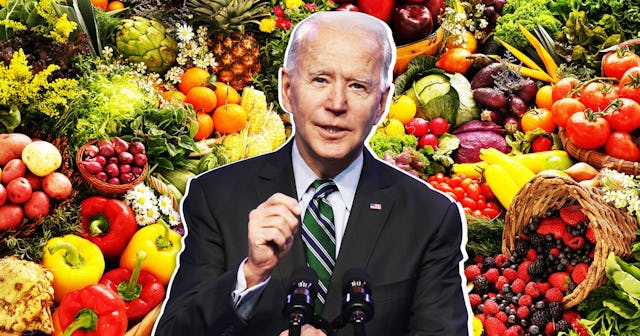Why The Biden Administration's Expansion Of The Universal Free Lunch Program Means So Much

The U.S. Department of Agriculture has announced that it will continue its universal free-lunch program through the 2021-2022 school year, extending the previously announced deadline of Sep. 30. This is an effort to provide nutritionally-based meals for more than 12 million American children facing food insecurity. This program directly aligns with the Biden-Harris Administration’s commitment to reopen schools safely.
According to Feeding America, in 2018 1 in 9 Americans experienced food insecurity. This included 11 million children. These numbers have undoubtedly increased since the onset of a global pandemic. Children were forced out of their schools and into their homes, where many did not have access to nutritious food. Imagine how scary it must be to suddenly not know where your breakfast or lunch is going to come from.
The pandemic catapulted millions of American families into food insecurity. Parents who once had stable jobs are now without work and limited funding to feed their families. They may not have been on a list for free lunch and were left scrambling. The USDA introduced its child nutrition program waivers last spring as a way for any student who needed food to be able to get it from their school. The waivers also allowed schools to have flexibility to feed their students in more non-traditional ways. This included parents being able to pick up multiple meals at a time for their child, or to have the food delivered to their home if they were unable to arrange pickup. This increased flexibility has been tremendously successful.
Kids are getting an opportunity to be kids, with one less worry. So many children are carrying the weight often reserved for adults. They are concerned about their family’s health and safety. They fear that they may never get to see their friends or be back in a normal school environment. Their parents are out of work and they wonder if they will be able to stay in their home. Knowing that they are able to get at least one healthy meal a day is a relief to millions of kids. It gives a bit of normalcy when our world is anything but normal.
Schoolnutrition.org reports that 29.6 million students in 100,000 schools and institutions are served through the National School Lunch program each day. That is 4.9 billion lunches served annually to children who would otherwise not have access to a nutritionally-based meal.
Alex Wong/Getty
During the upcoming school year, schools will continue to be able to serve meals through the USDA’s National School Lunch Program Seamless Summer Option. That program is normally only offered during the summer months. This option gives schools the tools they need to offer the nutrient rich meals fitting the USDA’s standards. This includes fruits, vegetables, milk, whole grains and sensible calorie levels. Additionally, schools participating in this program will receive per meal reimbursement at a higher level than normal, to account for changes in operational expenses.
According to the USDA, this extended free lunch program announcement is aligned with other USDA efforts to enable better food security to millions of Americans, to combat hunger, and to place more emphasis on the importance of nutritional foods. The Biden-Harris Administration’s American Rescue Plan Act will provide more than $12 billion in new nutrition assistance. This will include:
An additional $1.1 billion per month for approximately 41 million participants by increasing SNAP benefits 15% through September 2021
To support those particularly impacted by the pandemic, there will be $1.1 billion in funding for territories operating nutrition assistance block grants; these areas are home to 3 million Americans.
Through the duration of this public health emergency P-EBT services will be extended and expanded to serve more than 8 million American families with children. The Child and Adult Care Food Program will fund meals for young adults who are homeless. Women, infants and children will receive nearly $900 million through the Special Supplemental Nutrition program that will include an additional $35 in monthly fruit and vegetable vouchers to serve more than 6.2 million people who use the WIC program.
Under the Biden-Harris Administration, the USDA’s goal is to transform America’s food system. With an emphasis on ensuring that communities have access to safe, healthy and nutritious foods, while battling food insecurity. Making school lunch programs available for all children is a great way to start.
“Students’ success in the classroom goes hand in hand with their ability to access basic needs like healthy and nutritious meals,” said Secretary of Education Miguel Cardona in a USDA statement. “It’s critical that our efforts to reopen schools quickly and safely include programs that provide access to free, healthy meals for our most vulnerable students, particularly those whose communities have been hardest hit by the pandemic. This program will ensure more students, regardless of their educational setting, can access free, healthy meals as more schools reopen their doors for in-person learning.”
No child should have to worry about where their next meal is coming from. Thankfully, President Biden recognizes the problem and is coming to the aid of millions of American children helping to reduce food insecurity and to ensure their health and success both inside and outside of the classroom.